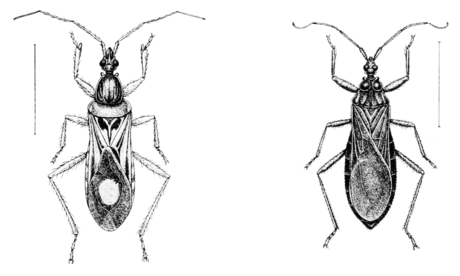Texas, is interesting as having occurred in bed. The patient was bitten on the hand, with very painful results and bad swelling.
The third of the Eastern species, Coriscus subcoleoptratus, is said by Uhler to have a general distribution in the Northern States, and is like the species immediately preceding a native insect. There is no record of any bite by this species, and it is introduced here for the reason that it attracted the writer's attention crawling upon the walls of an earth closet in Greene County, New York, where on one occasion it bit him between the fingers. The pain was sharp, like the prick of a pin, but only a faint swelling followed, and no further inconvenience. The insect is mentioned,
 | ||
| Rasatus biguttatus. Twice natural size. (Original.) | Reduvius Opsicostes personatus. Twice natural size. (Original.) | |
however, for the reason that, occurring in such situations, it is one of the forms which are liable to carry pathogenic bacteria.
There remain for consideration the Southern and Western forms—Rasatus thoracicus and R. biguttatus, and Conorhinus sanguisugus.
The two-spotted corsair, as Rasatus biguttatus is popularly termed, is said by Riley to be found frequently in houses in the Southern States, and to prey upon bedbugs. Lintner, referring to the fact that it preys upon bedbugs, says: "It evidently delights in human blood, but prefers taking it at second hand." Dr. A. Davidson, formerly of Los Angeles, Cal., in an important paper entitled So-called Spider Bites and their Treatment, published in the Therapeutic Gazette of February 15, 1897, arrives at the conclusion that almost all of the so-called spider bites met with in southern California are produced by no spider at all, but by Rasatus biguttatus. The symptoms which he describes are as follows: "Next day the injured part shows a local cellulitis, with a central
